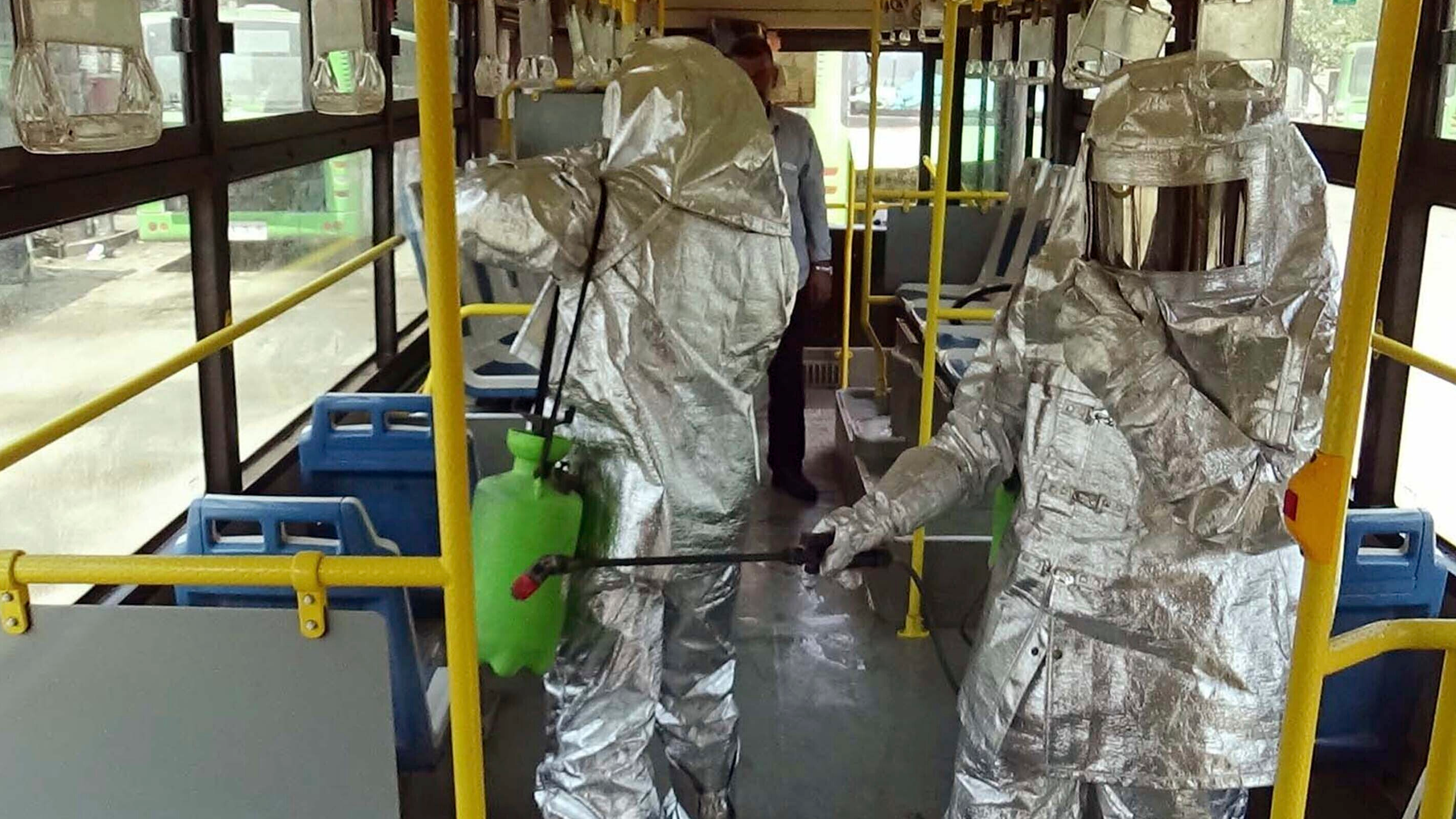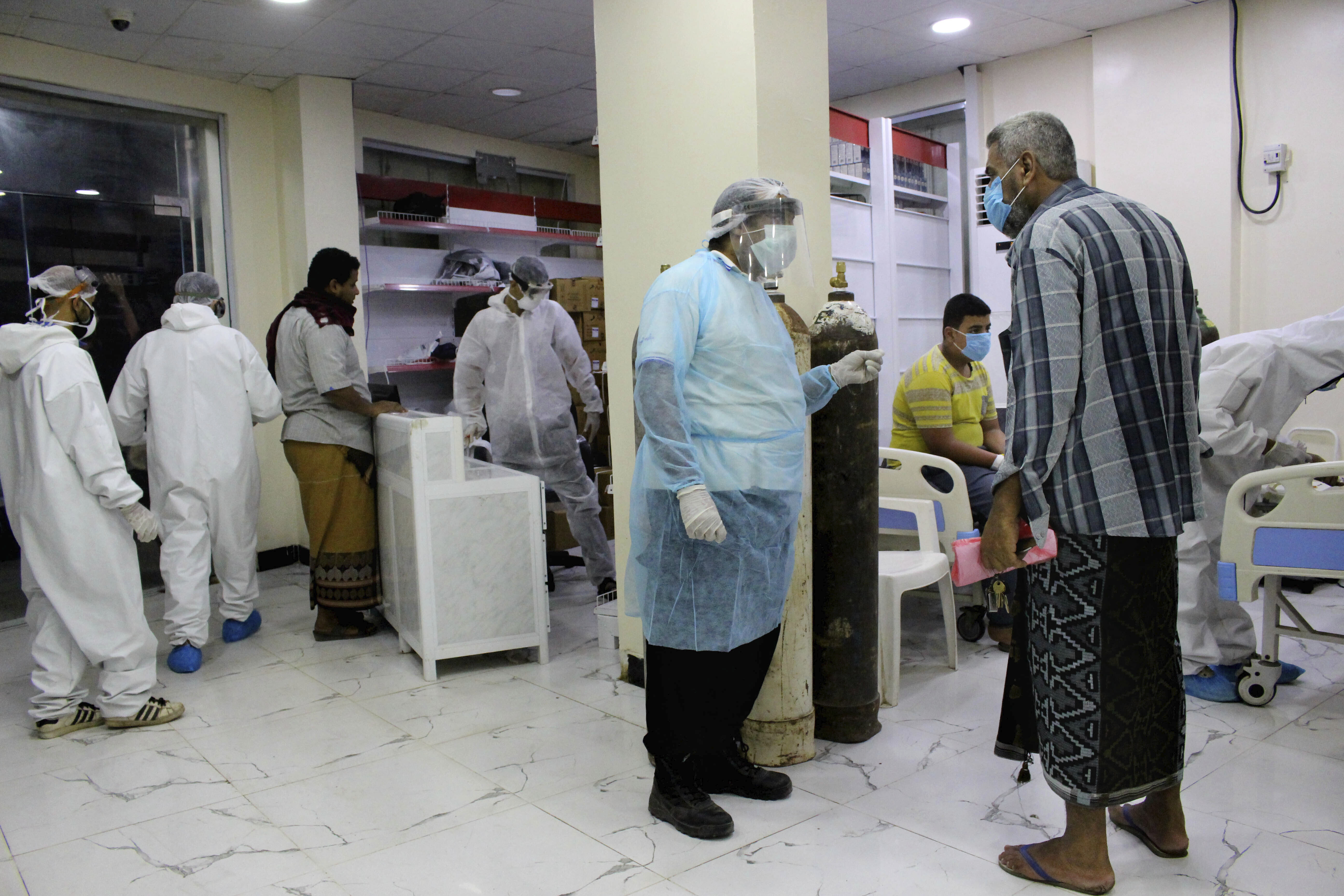
Workers wear protective gear spray disinfectant as a precaution against the coronavirus outbreak inside a public bus in Aleppo, Syria, March 15, 2020. /AP
Workers wear protective gear spray disinfectant as a precaution against the coronavirus outbreak inside a public bus in Aleppo, Syria, March 15, 2020. /AP
Editor's note: Guy Burton is an adjunct professor at Vesalius College, Brussels. The article reflects the author's opinions, and not necessarily the views of CGTN.
As the midpoint of the year approaches, what is the current situation regarding the main conflicts taking place in the Arab world? How close or far are they from resolution and what has been the impact of the unexpected impact of the COVID-19 pandemic been on them?
The short answer is that the likelihood of conflict ending in any of the three major hotspots of Libya, Syria and Yemen is remote. But beyond that there is considerable variation. In Libya there have been substantial changes between the principal belligerents, while in Yemen the main division has occurred among key allies, while in Syria tensions have emerged within the ruling elite.
At the same time, these developments have occurred separately from the global COVID-19 pandemic. Compared to elsewhere, the virus and its transmission took place later, giving governments time to watch and learn how to respond. Practically though, that advantage may be scrubbed out during the second half of the year as these states lack sufficient infrastructure and resources to curb its spread.
In Libya, General Khaled Haftar and his Libyan National Army looked to be in a strong position to gain power over the whole country at the start of the year.
Having been the dominant force in the country's east since 2014, Haftar launched a major offensive against the UN-backed and Tripoli-based Government of National Accord (GNA) in April 2019. Although his advance began to slow, he was still confident enough that he rejected a proposed ceasefire in January.
The GNA's vulnerability prompted it to reach out to Turkey late last year for military assistance. That support came online after January. By May the GNA had begun to push Haftar back as well as retake territory in the country's west. By early June Haftar was said to be seeking a truce, but this time the GNA wasn't interested.
While the momentum is with the GNA, a conclusive end to the war remains far off.
The GNA-Haftar conflict has also exposed the regional dimension of the war. The GNA's recovery has bolstered the status of its backers, Turkey and Qatar, while Haftar's retreat reflects badly on his supporters, Egypt and the United Arab Emirates (UAE). These two, along with Saudi Arabia, are also caught up in their own regional rivalry with Qatar (and Turkey), the third anniversary of which passed last week.

Yemeni medical workers wearing masks and protective gear talk to patients suspected of having the coronavirus at a hospital in Aden, Yemen, May 20, 2020. /AP
Yemeni medical workers wearing masks and protective gear talk to patients suspected of having the coronavirus at a hospital in Aden, Yemen, May 20, 2020. /AP
In Yemen the most visible developments have been between allies: the government of Abdrubbah Mansur Hadi and the Southern Transitional Council (STC). While Hadi claims authority over the whole of Yemen, the Southern Movement wants to secede and reestablish an independent South Yemen, which existed before 1990.
Differences between the two were suppressed by their joint opposition towards the Houthis, who are fighting for greater autonomy in the north of the country. In 2015, Saudi Arabia and the UAE intervened, to support Hadi. But in summer 2019, the UAE announced it was reducing its military presence.
Fighting took place between the government and the STC. Saudi Arabia stopped it by brokering a power-sharing agreement. But the STC has grown unhappy with Hadi since the start of the year and claim that he didn't honor his side of the bargain. In April, they broke with him, seized control of Aden and declared self-rule.
The STC's demands went unchallenged. Although strong in Aden, there are other groups who have more influence in the south and contest the STC's claim. Trying to beat or win them over will therefore be a big challenge for the STC over the rest of the year.
Meanwhile, in Syria, major fighting looks to be ending soon. Compared to previous years, the Assad government has not only survived but recovered much of the country while the opposition has been squeezed into the northern Idlib province.
Now the major fault lines are within the government and what the direction it should take. This is reflected in the rivalry between President Bashar al-Assad and his cousin, Rami Makhlouf, who has major economic interests, including ties in the country's oil, construction, banking and telecommunications sectors.
Despite the differences in each country's conflict, one common point for all is the current COVID-19 pandemic. In all three countries, COVID-19 arrived late, the first cases were diagnosed in Syria and Libya in late March and in Yemen in April. Currently, the numbers are low – around 125 in Syria, 250 in Libya and nearly 500 in Yemen – although it is likely that the figures are underreported.
The late arrival of COVID-19 was most likely due to the relative isolation of the three countries, owing to conflict. By contrast, much of COVID-19's early transmission took place through the Arab Gulf countries, whose economies are open to large numbers of foreign workers and which are major global transport hubs.
Despite COVID-19's late arrival, the three countries have few advantages. Because of conflict, their health care systems and infrastructure are in a poor state. Economically too, they lack revenue to acquire necessary resources. In April, the IMF predicated that the most fragile and conflict-affected parts of the Middle East would see GDP fall by seven percent this year, more than double the estimated 3.1 percent contraction for the region as a whole.
Looking towards the second half of the year, despite the different stages of conflict in each country, the broader economic and health situations look ominous. While they have so far managed to avoid being adversely affected by COVID-19, this may soon change. Should that happen, then it is likely that public health issues may soon find themselves wrapped up in conflict dynamics in a way that they weren't during the first half of 2020. That may well influence the fortunes of different conflict parties, perhaps by diminishing some parties and enhancing that of others.
(If you want to contribute and have specific expertise, please contact us at opinions@cgtn.com)